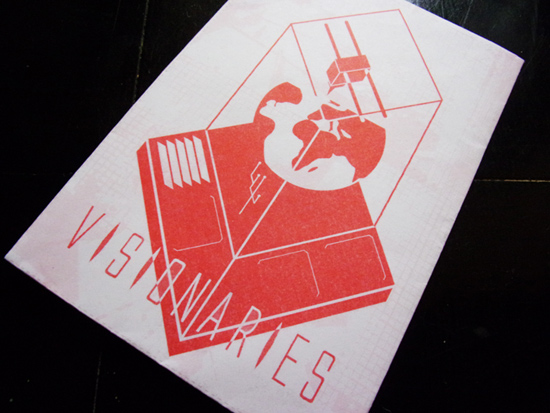
The Visionaries illustration research network symposium was held over 5th and 6th November 2015 at Birmingham City University. We present a short report on the event:
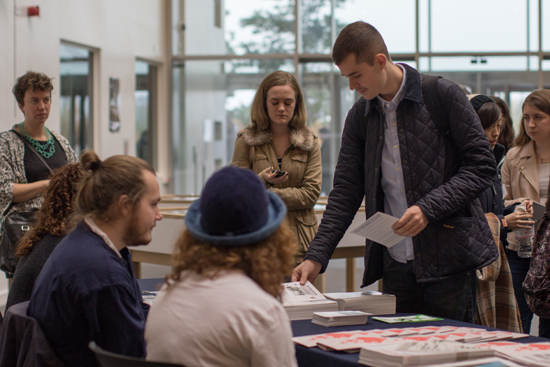
Visionaries delegates signing in. Photograph by Kendall
The event was the result of the VaroomLab call for paper on the theme of Visionaries, and investigated the way visionary approaches are able to expand the way we perceive the world, and also how influences from the past continue to resonate today. The two day event was roughly divided into two themes: day one approaching the future, and day two investigating existing and past elements of illustration.
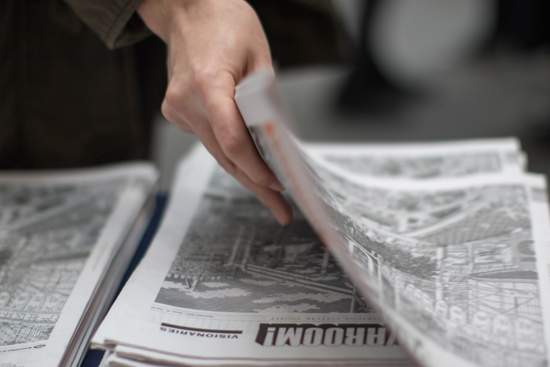
Issue 31 of Varoom (Visionaries) was available for delegates. Photograph by Kendall
Day One – 5 November
AOI’s VaroomLab administrator, Derek Brazell introduced the event on the first day with a brief history of VaroomLab, which was established in 2010 to provide a platform for exchange and discussion of ideas around the broad subject of illustration and expand knowledge and understanding of the subject.
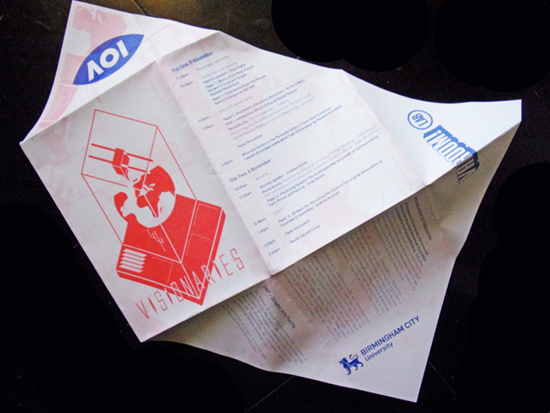
Visionaries fold out programme
Birmingham City University’s Professor of Illustration, Andrew Kulman, then introduced the first keynote speaker, illustrator Paul Slater. Slater discussed the approach to his surreal and humourous image making and his key interests, telling stories around the narratives and production of his illustration and personal work, “As soon as I stop doing commissions, I start painting”.
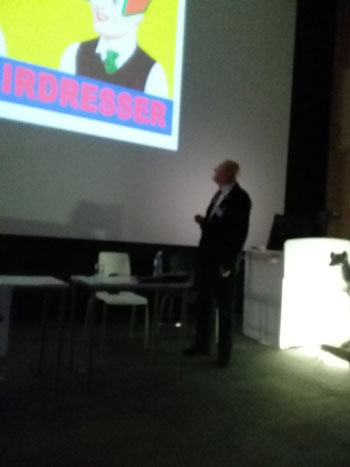
Paul Slater. Photograph by Derek Brazell
He covered sketchbook artwork, “When you’re doing finished work, it’s nice to then do rough drawings”, and talked about the way he paints, saying he rarely works from life (“I love drawing from my head – a fanciful thing”), but works fast: “I’ve always considered myself a dope, but I do all my paintings in a day”. Slater made a good start to the day, grounding the visionary in the creations of the working illustrator, all with amusing anecdotes and pertinent insights.
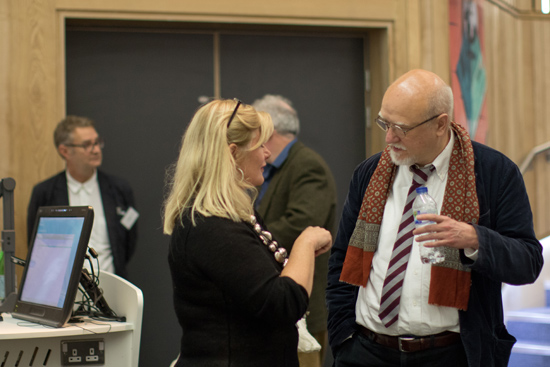
Paul Slater talking to Jo Berry. Photograph by Kendall
Matthew Richardson then presented the first paper of the event, Myths of the near Future: Ballard, Crusoe and Google. Richardson’s talk explored and described, through work in progress of a project titled ‘Am I the Island’, where we travel (via Google Streetview) through the physical and metaphoric spaces described in J.G. Ballard’s 1973 novel Concrete Island – a re-casting of the Robinson Crusoe myth, searching for a modern day interpretation by starting with Google maps viewpoint of the exact spot in the novel where the main character crashes off the motorway.
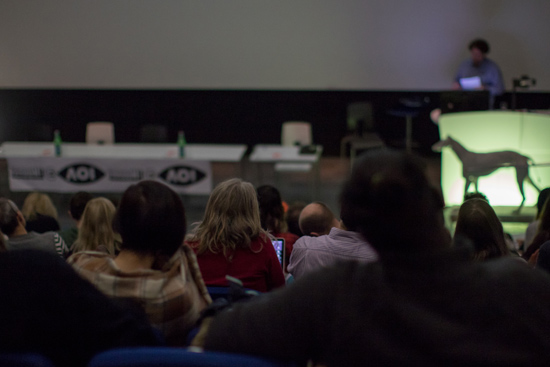
Matthew Richardson. Photograph by Kendall
Richardson talked about “Culture myths that question what it is to be human” and investigated how Ballard’s visionary narrative was written 40 years ago relating it back to the present, and the technological uncanny.
Field Notes From The Future followed, presented by Gareth Proskourine-Barnett, whose starting point was Brutalist architecture. He told the audience that buildings in the Brutalism style are now becoming listed and so are once more being noticed again, “Back in vogue”, so there is an element of nostalgia, but with social principles which underline the form of the buildings.
This was focused on Birmingham Central Library, built in 1974, which is to potentially be demolished to make way for new buildings in the city center. Proskourine-Barnett asked, “Does this building have a virtual afterlife?” and discussed how during recording, when Brutalism is digitized, it becomes unstable.
This presentation covered a recent project, and work in progress, on the Central Library, with the resulting works using Post-Digital and Post-Internet practices to construct and archive virtual manifestations of the sublime, playing with the assertion and distortion of narrative upon place. These works are an attempt to describe a world where history is written to alter the future, where new narratives are constructed and where archaeology and futurism merge. He ended with a film – his “love letter” to the Central Library.
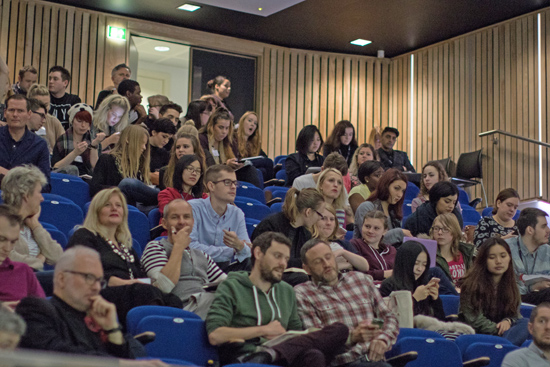
Then Visionaries audience. Photograph by Kendall
Richard Miles’ paper, Illustration; Education; Revolution, focused on alternatives to current educational structures and discussed the ‘financialisation’ of education.
He talked about how, in the refigured HE landscape, the burden of financing education has been placed squarely on the shoulders of the individual, who is now encouraged to view their education as a form of human capital investment.
Miles’ paper drew upon the thoughts of the philosopher Jacques Rancière to point to a particular ‘distribution of the sensible’ currently in operation within the field of visual arts practice, institutionally and culturally. For Rancière, the ‘distribution of the sensible’, refers to implicit conventions, laws, regulations, social structures, behaviours, and modes of consciousness, which separate individuals or social spheres from each other, preventing participation in the creation of a common world.
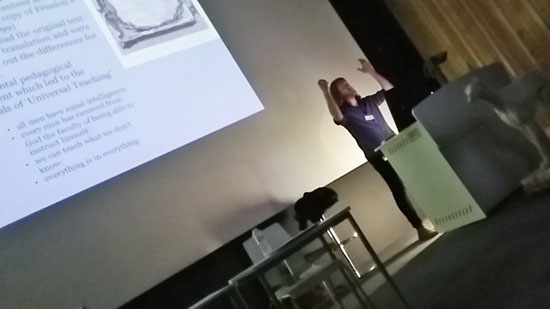
Richard Miles. Photograph by Derek Brazell
Miles described the achievements of ‘The School of the Damned’, a one-year course, autonomously organised and run by its students, equivalent in structure and rigour to an accredited MA, as a potential alternative to conventional educational structures. He hoped the audience could “envisage a future for arts education that transcends institutional and disciplinary limitations and, indeed, capitalist societal relations themselves”.
Darryl Clifton and Rachel Gannon then introduced their film, Immaterial Boundary, stating their interest lies in the manifestation of vision/visionary-ness in contemporary Illustrative practice.
Assuming a conflated definition of the visionary – one where the future facing ‘leader’ is blended with the imaginative ‘seer’ – they want to investigate visionary-ness in the new and emerging forms Illustration takes.
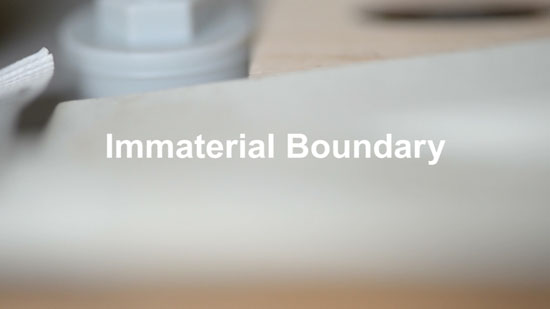
Immaterial Boundaries title still
With a general focus on nascent visual language and style that extends the boundaries of the discipline, as well as notions of thing-ness, materiality and immateriality they have filmed case studies and interviews with practitioners. The intention being to scrutinize the nature of their work, their motives, aspirations and visions.
The film reviewed the work of four contemporary Illustrative practitioners whose work is derived from the discipline of illustration, but occupies territory on the periphery of mainstream practice. These are Peter Nencini, Anna Lomax, Pablo Jones Soler and Jack Sachs.
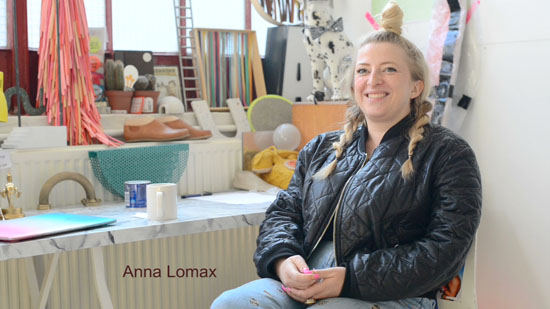
Immaterial Boundaries interviewee Anna Lomax
Arguably, Clifton commented, the work shown constitutes a vision for the discipline, work that embraces, as well as critiques, the prevailing contemporary working paradigm for Illustrators; conditions that are fluid and unstable. It is also work that proposes new visual languages for audiences and Illustrators, challenging modes of content dissemination and dialogue.
Gannon described the process behind the film, which is part of a larger project, where the four practitioners discussed similar themes: Material; Style; Boundaries and Craft.
Next up were three Pecha Kucha presentations by Jo Berry, Christian Lloyd and Jo Hassall. A Pecha Kucha is a short 6.40 minute presentation (20 slides x 20 seconds per slide).
Jo Berry presented ‘The in-betweener’, five case studies of her work with scientists, “Working on the edges of disciplines, as ‘in-betweener’ is a place and a term I see myself very much fitting into: a Visual Interpretator”. Berry described how these collaborative ventures with scientists who use digital imaging techniques as part of their primary research has inspired very productive collaborations, and has enabled a cross-pollination of ideas. The collaborations have served as a vehicle to create new material, new methods of working and new production techniques. A profitable place to inhabit where the interplay of art, design, science and technology continues to offer a space to learn from each other.
Christian Lloyd’s Performing in a do-It-yourself nudie suit presentation charted the re-interpretation of the rhinestone cowboy nudie suit by Lloyd’s performance group The Bongoleeros. The nudie suit was developed in the 1940s in the USA, and was worn by recording artists and actors including Hank Williams, Elvis Presley and Roy Rogers.
The Bongoleeros “less avant garde, more ‘ava go” approach aims to explore the frictions between comedy and threat, and simplify rock and roll to essential gestures, costumes, minimal lyrics and music. The band have developed a number of hand-painted nudie suits that reflect their do-it-yourself values, re-interpret the iconography of rock and roll, and offer a new platform to see the crossover of illustration with music, sound and performance. This has included children’s parties.
Lloyd revealed his first illustration commission was painting on to punk jackets
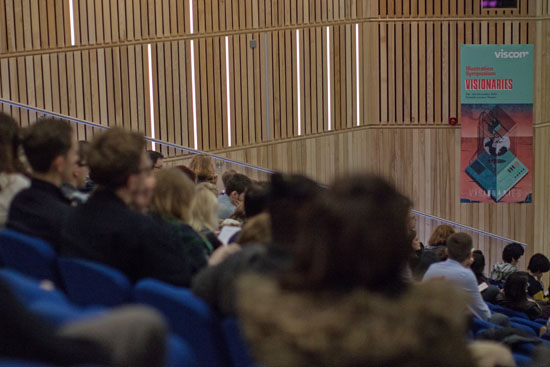
The Visionaries audience. Photograph by Kendall
Jo Hassall’s Off her hostess-trolley: Telling it a different way confronted the spectacle of the familiar 1970’s food warming hostess-trolley as a central prop – her presentation charted a process-led encounter with the object/image as a site for critical excavation and potential change.
As teller of this process story, Hassall demonstrated ways in which playful acts have become pivotal research approaches within her work – helping to un-stick and mobilise her established practice, and as a way of expanding on story-making and story-telling.
A lively Panel Discussion concluded the first day, with presenters answering questions from the audience. A relevant point to the discussion was given by Matthew Richardson, “I’m interested in illustration as an idea”.
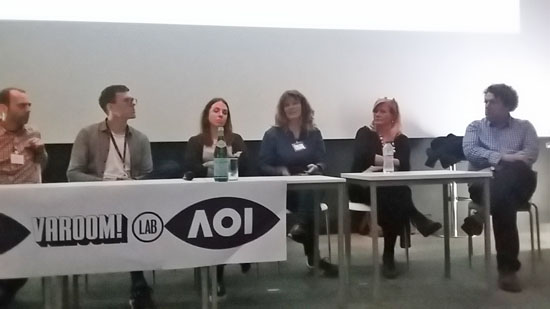
Panel left to right: Christian Lloyd, Gareth Proskourine-Barnett, Rachel Gannon, Jo Hassall, Jo Berry and Matthew Richardson. Photograph by Derek Brazell
A reception was then held in the university entrance hall, which was showing a Punk exhibition including posters, record sleeves and other memorabilia, and Richard Schofield launched his concertina publication I am still asleep, inspired by the writing of William Goldman.
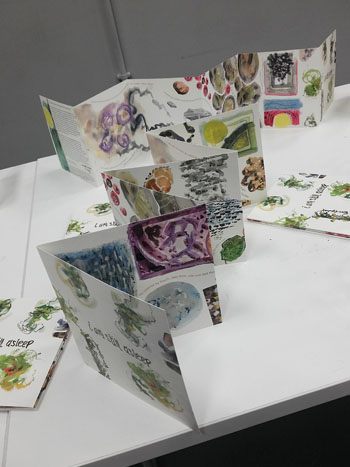
Richard Schofield’s I am still asleep
Day Two – 6 November
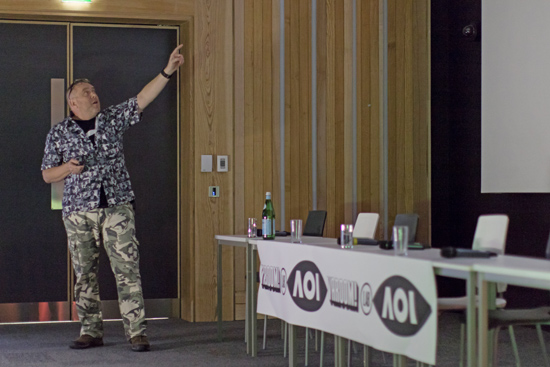
Graham Elliot. Photograph by Kendall
The first presentation of the day was keynote speaker, Graham Elliot. Elliot introduced his body of work with a film mash up of his film, video and animation work, which he followed with his career from his time at the Royal College of Art (RCA) in the 1980’s, where he met John England with whom he founded the Thunder Jockeys design group, through to his current film/documentary work.
For this part of his presentation, Elliot showed some sketches that he’s drawn on the Visionaries paper programme on the first day of the conference, illustrating part of his RCA narrative (which included a very entertaining story about Price Charles and a scab…).
He has always attached great importance to storyboards for film and video work, showing a strong selection of storyboard sketches – “Illustration is there to be part of the project”.
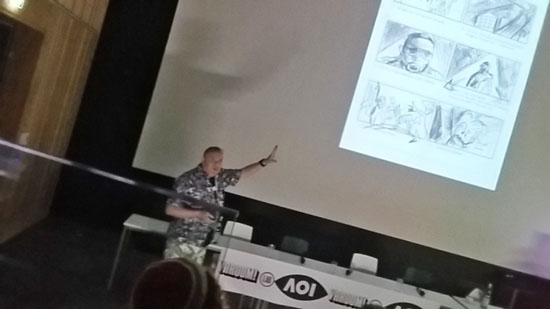
Graham Elliot discussing illustrated storyboards. Photograph by Derek Brazell
Several projects have taken him around the world and he has lived in America for many years. One music video commission there ended with a very dissatisfied rapper and his manager being rather threatening; “You don’t normally get an illustration job that can kill you!” joked Elliot.
Following were two Pecha Kucha presentations. Chloe Regan spoke on the Illustrator as Detective: Discovery through Drawing, covering her project with the Museum of East Asian Art which holds a collection of ceramics, jades, bronzes and other artefacts from China, Japan, Korea and Southeast Asia. From her observations, Museum visitors don’t simply look, so for this project Regan is exploring drawing as a tool for “looking beyond the obvious”, to truly study and discover an object within a museum collection.
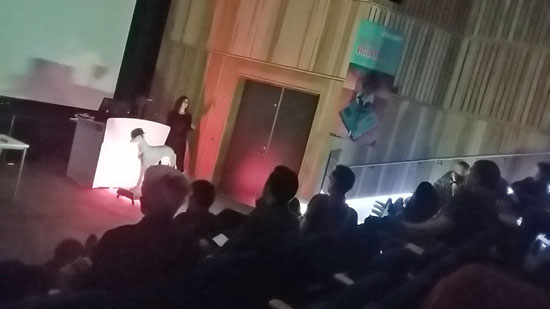
Alice Moloney. Photograph by Derek Brazell
Alice Moloney’s Pecha Kutcha was titles A New Breed: How should we champion the mavericks and pioneers of the illustration industry?Moloney’s presentation was based on her belief that a new breed of illustrator is emerging. One driven by ideas, problem solving, and working in teams. Who use drawing as a tool rather than as a way of visualising someone else’s ideas or words. She stated that “Brands need illustrators”
The next paper was Visualising Spaces: The Illustrated Map as a mode of communicating Fact, Fiction and Feeling from Andy Davies. Davies’ aim was to show that the illustrated map is not mere decoration, but a visual language providing an allegorical response to tangible places and personal feelings.
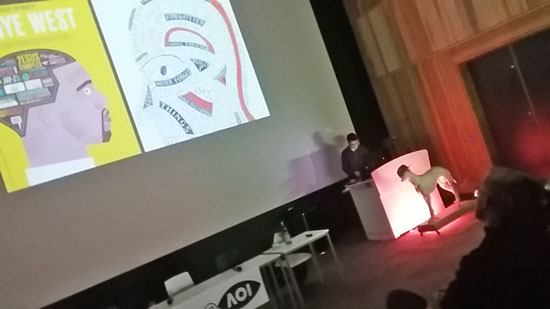
Andy Davies. Photograph by Derek Brazell
He did this by looking at a variety of historical and contemporary illustrated maps and artists (such as Grayson Perry), who track their journeys through drawing, both conventional and emotional journeys.
These covered the spectrum from the Mappa Mundi in Hereford cathedral via Veit Schustz’s New York Subway Penis Map poster for a Cosmic Art Enterprises’ art show to Steve Simpson’s Dublin map produced for Jameson Whiskey.
Andrew Kulman next presented 40 Years On: revisiting the vision of the original Association of Illustrators (AOI) committee. The early history and goals of the AOI was detailed by Kulman, covering the establishing of the code of practice for members, the valuable Acceptance of Commission form and the ‘return of artwork’ stickers produced for placing on physical artworks, “The AOI provides so many things that help us as professionals”.
The AOI’s various publications were shown by Kulman, from the early black and white newsletters, through the two colour Journal to the full colour Varoom magazine, and he highlighted articles and issues that arose over the years.
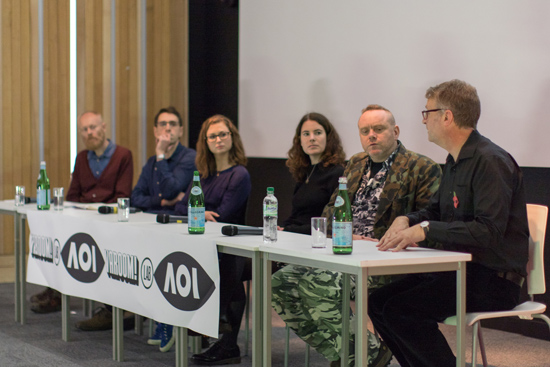
The panel, left to right: Derek Brazell, Andy Davies, Alice Malony, Chloe Regan, Graham Elliot, Andrew Kulman. Photograph by Kendall
The event concluded with another spirited Panel Discussion which extended well beyond its allotted time, rounded up the event, and lead to many positive comments on the whole conference.
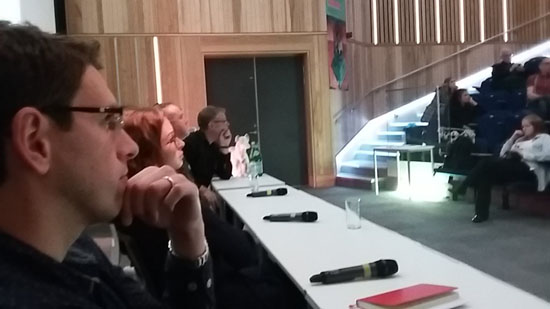
Panel and audience discussion. Photograph by Derek Brazell
More details on the talks can be seen here.